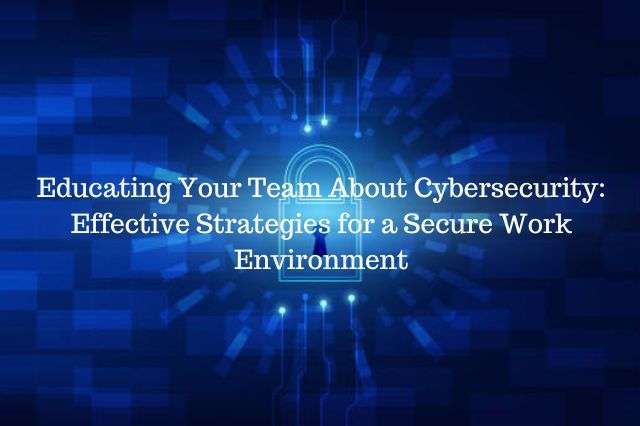Educating Your Team About Cybersecurity: Effective Strategies for a Secure Work Environment
In today’s digital age, cybersecurity is a paramount concern for businesses of all sizes. The ever-evolving landscape of cyber threats requires constant vigilance and proactive measures to protect sensitive data and maintain the trust of clients and customers. One of the most critical aspects of cybersecurity is educating your company or team members. This article explores various strategies to educate your team about cybersecurity, including the use of webinars as an effective tool.
Why Cybersecurity Education is Crucial
Before diving into specific strategies, it’s important to understand why cybersecurity education is crucial for your organization. Cyber threats are constantly evolving, becoming more sophisticated and damaging with each passing day. A lack of awareness and preparedness can result in data breaches, financial losses, and damage to your company’s reputation.
By investing in cybersecurity education, you empower your team members to recognize and mitigate potential threats. This not only protects your organization but also fosters a culture of responsibility and accountability where everyone plays a role in safeguarding sensitive information.
Effective Strategies for Cybersecurity Education
Webinars
Webinars are an excellent way to deliver comprehensive cybersecurity training to your team. They offer the flexibility of remote learning and can accommodate a large audience. Here’s how you can make the most of webinars for cybersecurity education:
Engaging Content: Ensure your webinars are engaging by using real-life examples, case studies, and interactive elements like polls and quizzes. This keeps participants attentive and helps them apply what they’ve learned.
Expert Speakers: Invite cybersecurity experts or professionals to conduct the webinars. Their knowledge and experience add credibility to the content and provide valuable insights.
Regular Schedule: Establish a regular schedule for cybersecurity webinars. This helps in creating a routine for team members to participate in ongoing education.
Recording and Accessibility: Record the webinars for those who can’t attend in real-time. Make these recordings accessible on your company’s learning management system or intranet for future reference.
Phishing Simulations
Phishing attacks are a common entry point for cybercriminals. Simulations can help your team recognize and resist these attacks. Here’s how to implement phishing simulations effectively:
Realistic Scenarios: Create phishing emails that mimic real-world situations and common tactics. Ensure that the emails are convincing but not malicious.
Feedback and Analysis: Provide immediate feedback to employees who fall for phishing simulations. Use these incidents as teachable moments to educate them about the red flags they missed.
Progress Tracking: Keep track of each team member’s progress in recognizing and reporting phishing attempts. Recognize and reward those who consistently excel at identifying threats.
Regular Workshops
In addition to webinars, conduct regular workshops on specific cybersecurity topics. These workshops can be more hands-on and allow participants to delve deeper into areas of interest or relevance to their roles. Topics may include data encryption, password management, and secure communication practices.
Customized Content: Tailor the workshop content to the specific needs and roles of your team members. A one-size-fits-all approach may not be as effective.
Practical Exercises: Incorporate practical exercises and demonstrations to help participants apply their knowledge in a controlled environment.
Security Awareness Campaigns
Launch security awareness campaigns that run throughout the year. These campaigns can include posters, email reminders, and short video clips highlighting the importance of cybersecurity.
Themes and Challenges: Keep the campaigns engaging by introducing themes and challenges that encourage participation. For example, a “Cybersecurity Quiz of the Month” can pique interest and test knowledge.
Feedback Mechanism: Create a feedback mechanism where team members can report suspicious activities or share cybersecurity-related concerns.
Gamification
Gamify cybersecurity education by turning it into a fun and competitive experience. Create interactive games and challenges that encourage team members to learn and apply cybersecurity principles.
Leaderboards: Maintain leaderboards to showcase the top performers. This healthy competition can motivate employees to stay vigilant.
Rewards: Offer rewards or recognition for outstanding contributions to cybersecurity awareness and best practices.
Conclusion
Educating your company or team members about cybersecurity is a proactive measure that pays off in the long run. It equips your team with the knowledge and skills needed to protect sensitive data and maintain a secure work environment. Implementing strategies like webinars, phishing simulations, workshops, awareness campaigns, and gamification can create a robust cybersecurity culture within your organization. Remember that cybersecurity education is an ongoing process as threats continually evolve, so make it a priority to keep your team members well-informed and vigilant.





